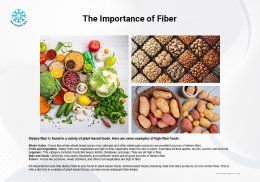Debunking the Myth: "All Carbs Are Bad!"
Last updated: 18 May 2023 | 1160 Views |

In recent years, carbohydrates have gained a notorious reputation, with some popular diets even labeling them as the enemy of weight loss and overall health. However, the blanket statement that "all carbs are bad" is a considerable oversimplification and, frankly, a misconception. Carbohydrates, like any other nutrient, are crucial for our bodies, and understanding their complexity is key to maintaining a balanced, healthy diet.
- Protein provides 4 calories
- Carbohydrate provides 4 calories
- Fats provide 9 calories
Understanding Carbohydrates
Carbohydrates are one of the primary macronutrients, along with proteins and fats. They serve as a primary source of energy for the body. The brain, in particular, relies heavily on glucose, a type of carbohydrate, to function effectively. However, not all carbohydrates are created equal. They can be classified into two main types: simple carbohydrates and complex carbohydrates.

Simple vs Complex Carbohydrates
Simple carbohydrates, or sugars, can be naturally occurring (as in fruits and milk) or added to foods (as in sweets, pastries, and soft drinks). They are rapidly digested and absorbed, causing a quick surge in blood sugar followed by a steep drop, often leaving you feeling hungry sooner.
On the other hand, complex carbohydrates, found in foods like whole grains, legumes, and vegetables, are composed of longer chains of sugar molecules. These take longer to break down, providing a slow, steady release of energy and keeping you satiated for a longer period.
Monosaccharides, disaccharides, and polysaccharides
Monosaccharides, disaccharides, and polysaccharides are all types of carbohydrates, but they differ in their structure and complexity.
- Monosaccharides
These are the simplest form of carbohydrates and are made up of a single sugar molecule. They are the building blocks for all other types of carbohydrates. The most common monosaccharides are glucose, fructose, and galactose.- Glucose is the primary source of energy for the body's cells. It's used directly by our cells for energy, and it's also the form of sugar that gets stored in our liver and muscles as glycogen for later use. Consuming glucose causes the body to release insulin, which allows glucose to be used by the body's cells.
- Fructose is naturally found in fruits, some vegetables, and honey. Unlike glucose, fructose is processed in the liver. In moderate amounts, such as those found in whole fruits, fructose is perfectly healthy. However, a high intake of fructose, particularly from sweetened drinks and processed foods, can be harmful. It doesn't trigger insulin in the same way glucose does, which means it can contribute to weight gain and other health problems if consumed in excess.
- Galactose combines with glucose to form lactose, the sugar found in milk. Like glucose, galactose can be used by the body for energy.
- Disaccharides
These are made up of two monosaccharide molecules joined together. Common disaccharides include- Maltose (glucose + glucose): Maltose is produced in the body during the digestion of starch and is also found in certain foods and drinks, such as beer and malted milk. It has a sweet flavor but is not as sweet as glucose or fructose.
- Sucrose (glucose + fructose): Sucrose is naturally found in many fruits and vegetables, and it is also refined to produce granulated sugar. It's the sugar that is often used in baking and for sweetening foods and beverages.
- Lactose (glucose + galactose): This is the sugar found in milk and dairy products. Some people are unable to properly digest lactose, a condition known as lactose intolerance. In these individuals, consumption of lactose can lead to digestive symptoms like bloating, gas, and diarrhea.
- Polysaccharides
These are complex carbohydrates composed of long chains of monosaccharide units. They can be hundreds or even thousands of sugar units long. Starch, glycogen, and dietary fiber are examples of polysaccharides.- Starch is a carbohydrate found in many plants. It serves as a way for plants to store energy. When we eat foods rich in starch, like potatoes, rice, or corn, our bodies break the starch down into glucose to use for energy. Starches can be further classified as rapidly digestible, slowly digestible, or resistant (which acts like dietary fiber).
- Dietary fiber also known as roughage, dietary fiber is the part of plant-based foods (grains, fruits, vegetables, nuts, and beans) that the body can't fully digest. Although we can't break it down into sugar molecules as we do with other carbohydrates, fiber is an essential part of a healthy diet. It aids in maintaining a healthy weight, reducing the risk of heart disease, and supporting a healthy digestive system. There are two types of dietary fiber.
- soluble which can dissolve in water and helps to lower glucose and cholesterol levels in the blood.
- insoluble which does not dissolve in water and helps food move through the digestive system promoting regularity and preventing constipation.
- Glycogen is the storage form of glucose in animals and humans, which is stored primarily in the cells of the liver and the muscles. Structurally, it's very similar to starch. When the body has an excess of glucose, it stores it as glycogen for later use. When energy is needed, the body converts this stored glycogen back into glucose. This provides a quick source of energy for the body during physical activities and between meals. If your glycogen stores are full and you continue to consume more glucose than your body needs, the excess glucose can be converted to fat for long-term storage of energy.
In terms of digestion, monosaccharides are readily absorbed by the body since they are in their simplest form. Disaccharides and polysaccharides, on the other hand, need to be broken down into monosaccharides before they can be absorbed. This is why complex carbohydrates like polysaccharides typically provide a slower, more sustained release of energy compared to simple sugars.

The Importance of Fiber
Fiber, a type of complex carbohydrate, plays a vital role in maintaining health. Found abundantly in fruits, vegetables, and whole grains, fiber aids digestion, helps control blood sugar levels, lowers cholesterol levels, and promotes a feeling of fullness, reducing the likelihood of overeating.
Dietary fiber is found in a variety of plant-based foods. Here are some examples of high-fiber foods:
- Whole Grains
Foods like whole wheat bread, brown rice, oatmeal, and other whole grain products are excellent sources of dietary fiber. - Fruits and Vegetables
Many fruits and vegetables are high in fiber, especially when the skin is eaten. Examples include apples, berries, carrots, and broccoli. - Legumes
This category includes foods like beans, lentils, chickpeas, and peas. They are all high in fiber. - Nuts and Seeds
Almonds, chia seeds, flaxseeds, and sunflower seeds are all good sources of dietary fiber. - Tubers
Foods like potatoes, sweet potatoes, and other root vegetables are high in fiber.
It's important to note that dietary fiber is only found in plant-based foods. Animal-based foods, including meat and dairy products, do not contain fiber. This is why a diet rich in a variety of plant-based foods can help ensure adequate fiber intake.
Glycemic Index and Glycemic Load
The Glycemic Index (GI) and Glycemic Load (GL) are two factors that can help us understand the impact of different carbohydrates on blood sugar levels. Foods with a high GI are rapidly digested and absorbed, causing a quick spike in blood sugar. In contrast, low-GI foods take longer to digest, leading to a slower, steadier increase in blood sugar.
Glycemic Index (GI) is a measure that ranks carbohydrate-containing foods by how much they boost blood sugar levels. Foods are ranked on a scale of 0 to 100, with pure glucose given a value of 100. According to the University of Sydney's Glycemic Index Database and the American Diabetes Association:
- High GI Foods
White bread: GI 75
Instant white rice: GI 87
Russet potatoes (baked): GI 111
Pretzels: GI 83
Corn flakes: GI 81 - Low GI Foods
Lentils: GI 29
Barley (pearled, boiled): GI 25
Non-starchy vegetables (e.g., broccoli, bell peppers): GI often under 20.
Sweet potatoes (boiled): GI 46
Whole grain bread: GI 50-60
Glycemic Load considers both the quality (GI) and quantity (the amount consumed) of carbohydrates in a food, giving a more comprehensive view of how food may affect blood sugar levels. Consuming foods with a low GI and GL can help manage blood sugar levels, support weight management, and reduce the risk of type 2 diabetes and heart disease.
The journey of carbohydrates in our body
- Ingestion
The journey begins when you eat food containing carbohydrates. This could be something like an apple, a slice of bread, or a spoonful of rice. - Digestion
As you chew, saliva in your mouth starts the digestion process by breaking down some of the carbohydrates into smaller molecules. The food then travels down your esophagus and into your stomach, where it gets mixed with stomach acid to break it down further. - Absorption
The partially digested food then moves into your small intestine. Here, enzymes break the carbohydrates down into their simplest form, mainly glucose (a type of sugar). This glucose is absorbed through the walls of the small intestine and into your bloodstream. - Transportation
Once in your bloodstream, the glucose is transported to your body's cells. Insulin, a hormone released by your pancreas, helps your cells take in glucose. - Utilization
The cells use this glucose as fuel for all sorts of functions, from physical activity to brain functions and maintaining body temperature. - Storage
If there's more glucose than your body needs at the moment, it can be stored for later use. Some glucose is stored as glycogen in your muscles and liver. If these storage spaces are full, the extra glucose can be stored as fat. - Excretion
Any waste products from this process, along with undigested parts of the food (like some types of fiber), continue their journey through the large intestine, also known as the colon. Here, water and electrolytes are absorbed back into the body. The remaining waste, now formed into stool, is eventually excreted out of the body through the rectum and anus.
So, from start to finish, your body has systems in place to break down carbohydrates, transport them to where they're needed, use or store them, and safely get rid of any waste. All of these steps are crucial to keep your body functioning properly.
The statement "all carbs are bad" often arises from a misunderstanding of the types of carbohydrates and their effects on the body. Overconsumption of simple carbs, particularly those in highly processed foods, can indeed lead to weight gain and health problems. However, complex carbs and fiber-rich foods are a crucial part of a healthy diet, providing sustained energy and a wealth of other benefits.






